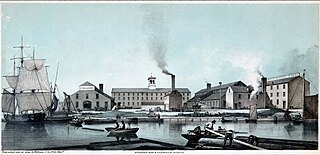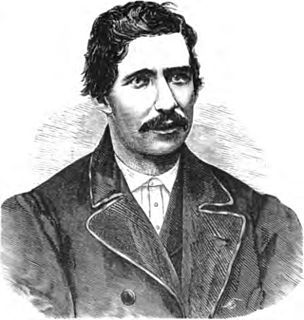Gallus Mag was a six-foot-plus tall, female bouncer at a 19th-century New York City bar called The Hole in the Wall. She figures prominently in New York City folklore. The name "Gallus" originated from the men's suspenders she was fond of wearing and "Mag" or "Meg" was likely her forename. The Hole in the Wall bar was at 279 Water Street, Manhattan, more recently the site of the historic Bridge Cafe.
Slobbery Jim was a leader of the 1850s New York City gang, the Daybreak Boys, which was formed in the late 1840s in Five Points slum with membership drawn from teenaged Irish immigrants. The gang committed robberies, ship sabotage, and frequent murders along the East River. The Daybreak Boys are believed to have caused the loss of at least $100,000 in property and committed at least twenty murders between 1850 and 1852.

Sadie Farrell was an alleged semi-folklorish American criminal, gang leader and river pirate known under the pseudonym Sadie the Goat. However, there exists doubt as to her historical existence.
Lewis "Lew" Baker was a patrolman in the New York Police Department who was simultaneously employed as a "slugger" for Tammany Hall. He was involved in voter intimidation and election fraud during the 1840s and 1850s. A close friend and associate of Irish mob boss John Morrissey, Baker frequently battled supporters of the nativist Know-Nothing movement for over a decade. He is most remembered however as the assassin of William "Bill the Butcher" Poole. Baker shot and killed Poole in a Broadway saloon during a brawl. Both Baker and Morrissey were placed on trial for murder, but were acquitted.

James "Wild Jimmy" Haggerty was an American criminal and well-known underworld mobfigure in Philadelphia and later in New York City during the mid-to late 19th century. Jimmy Haggerty was the leader of the Schuylkill Rangers, a predominantly Irish-American street gang, which terrorized the South Philadelphia waterfront, specifically its local wharves and coal yards, for over 25 years.
Mallet Murphy was the pseudonym of a popular American saloon keeper and underworld figure in Hell's Kitchen, New York during the late 1890s up until the start of the 20th century. His particular nickname was attributed to his use of a wooden mallet as a weapon against unruly customers and for defending his bar against criminals. His Battle Row saloon, located at Thirty-Ninth Street between Tenth and Eleventh Avenue, was used as the headquarters of the Gopher Gang during their early years.

Rosanna Peers (?-1840) was an American criminal fence and underworld figure in New York City during the early-to mid 19th century. She is the earliest known business owner to begin actively dealing with the city's emerging underworld and whose Centre Street grocery store and dive bar, established in 1825 just south of Anthony Street, was used as the longtime headquarters of the Forty Thieves upon their formation by Edward Coleman in 1826.
Peter Sawyer was an American thief and robber in New York City during the 1860s. A native of California, Sawyer appeared in New York's Forth Ward and the waterfront in the years following the American Civil War. He is credited as being the first criminal to drug victims for the purposes of mugging them. Although sailors' homes and crimp houses had previously been using "knock-out drops" and "slipping mickeys" to shanghai sailors, Sawyer was the first to make effective use for armed robbery. At first, Sawyer used simple snuff which he dropped into the victim's alcohol but perfected the practice later on with chloral hydrate. This was the drug of choice, with exception to the occasional use of morphine, preferred by those who followed Sawyer in similar robberies. Indeed, the practice became so common in the city that these men were referred to as "Peter Players" by the police and underworld alike.
The Potashes were a 19th-century Irish-American street gang active in Greenwich Village and the New York waterfront during the early to mid-1890s. One of the many to rise in New York City during the "Gay Nineties"-period, the gang was led by Red Shay Meehan and based near the Babbit Soap Factory on Washington Street near present-day Rector Street.
The Rhodes Gang was an American street gang based in New York City at the turn of the 20th century. The group was one of several smaller Hell's Kitchen gangs affiliated with the Gopher Gang, all of whom were almost constantly fighting among each other, among these including The Gorillas and the Parlor Mob. They were known, at times, to briefly put aside their differences when police attempted to interfere in gang fights and authorities found the area impossible to control.

Patrick Conway, commonly known by his alias Patsy or Patsy Conroy, was an American burglar and river pirate. He was the founder and leader of the Patsy Conroy Gang, a gang of river pirates active on the New York waterfront in the old Fourth Ward and Corlears' Hook districts during the post-American Civil War era.
Boiled (Biled) Oysters Malloy was the pseudonym of an American saloon keeper, thief and underworld figure in New York City during the mid-to late 19th century. He was especially known in The Bowery where he ran a popular basement bar and underworld hangout, located on Centre Street near the Tombs, known as The Ruins where "three drops of terrible whiskey were sold for a dime". His establishment was one of several owned by popular Bowery characters, most notably Mush Riley, whose dive bar was located just a few doors away from The Ruins. Malloy's nickname was derived from "his love of boiled oysters", and, according to Frank Moss in The American Metropolis from Knickerbocker Days to the Present Time (1897), when his mother commented on his diamonds and fine clothes would respond "Arrah, mother, I've struck it. I'm living on biled oysters."
Frank Stephenson was an American saloon keeper and underworld figure in New York City during the mid-to late 19th century. He was the owner of The Black and Tan, a popular Bowery basement bar located on Bleecker Street. It was one of the first saloons to cater to African-Americans and was a competitor against neighboring establishments such as Harry Hill's gambling resort and Billy McGlory's Armory Hall among others. He is also credited for opening the city's first and oldest "undisguised" gay bar, The Slide, also on Bleecker Street.
The Dump was a popular saloon and dive bar in New York City from the 1890s to about 1910. Owned by Jimmy Lee and Slim Reynolds, it was one of several establishments frequented by the underworld, most especially the Bowery Bums. It has been claimed that Tom Lee, head of the On Leong Tong, also ran the establishment at one time.
"Big" Jack Poggi or Pioggi was an American saloon keeper and underworld figure in New York City at the start of the 20th century. A rival of "Big" Jack Zelig, he had been the chief bouncer at Callahan's Dance Hall before opening a Lower East Side resort on Doyers Street near Chinatown's notorious "Bloody Angle". The building, known as Poggi's, could be reached through five Chatham Square alleyways, one of these being though a local dairy store and another through the back door of a barbershop, and was known to be a place "where anything goes". He later became partners with Chick Tricker, a member of the Eastman Gang, who bought an interest in his establishment to retain a connection in the district while he expanded his holdings elsewhere in Manhattan. His brother Louis "Louie the Lump" Poggi, a well-known gunman and member of the Five Points Gang, was responsible for the murders of Max "Kid Twist" Zwerbach and his bodyguard Vach "Cyclone Louie" Lewis in 1908.
Johnny Camphine or Camphene was the pseudonym of an American saloon keeper and underworld figure in New York City during the mid-to late 19th century. He was reputed to have run "one of the most notorious dives in the city", located at Mercer and Houston Streets. His name came from his serving colored camphine or rectified turpentine oil in place of whiskey; the latter was in use during the 19th century as a solvent for varnishes and as a fuel for lamps. On average, "two men a night were taken out of the place" after drinking Camphine's beverages and caused known cases of insanity and delirium tremens at least 100 patrons over a long-term period.
Red Light Lizzie was the pseudonym of an American madam, procuress and underworld figure in New York City during the mid-to late 19th century.
Thomas Hadden was American saloon keeper, criminal and underworld figure in New York City's infamous Fourth Ward during the mid-to late 19th century. He was the owner of a Cherry Street dive bar, a popular underworld hangout located next to Dan Kerrigan's place, and co-led the Dead Rabbits with Kit Burns. For over 25 years, his Water Street boarding house was one of the most notorious "crimp houses" on the New York waterfront as thousands of sailors were shanghaied, robbed or murdered. Hadden, and contemporaries such as Bill Slocum or John Allen, exercised considerable political influence in the city and were generally able to receive protection from city officials throughout their criminal careers.
Michael Mahoney, better known as Wreck Donovan or simply The Wreck, was a nineteenth-century American sneak thief, river pirate and underworld figure in New York City. He was a well-known criminal for hire on the New York waterfront during the post-American Civil War era and later became a member of Patsy Conroy Gang.
The Atlantic Guards were a 19th-century American street gang active in New York City from the 1840s to the 1860s. It was one of the original, and among the most important gangs of the early days of the Bowery, along with the Bowery Boys, American Guards, O'Connell Guards, and the True Blue Americans.




